Pran Maya Khadki comes from a small village called Namo Buddha, where our founder, Thrangu Rinpoche established Thrangu Tashi Yangtse Monastery. This is also where SMD Branch School for monks is. After she finished Class 10, Pran Maya took the three-year Health Assistants (paramedic) training. When the earthquakes hit in 2015, Lama Sangay, one of our monks in Malaysia raised enough money to equip a two-room tent that would act as a temporary health post in Sindhupalchok District, the epicentre of the second earthquake. He recruited Pran Maya to operate the health post and arranged for her to stay with his family for the four months she worked there. When she returned to Kathmandu, Pran Maya reported:
I went to Sindhupalchok District to provide healthcare services after the devastating earthquakes. I was there for four months and it turned out to be one of the greatest experiences of my life. I got this exciting opportunity through Lama Sangay, one of Thrangu Rinpoche’s monks, and a local of Sindhupalchok village. He requested me to take care of the sick patients as there was no health care provider during the catastrophe.
The real health post was destroyed by the earthquake, but the villagers helped me to set up a tent in which I created four separated rooms: dressing, check up, emergency and waiting room. After everything was arranged properly, I started to offer services to the patients and saw 30 to 40 patients per day.
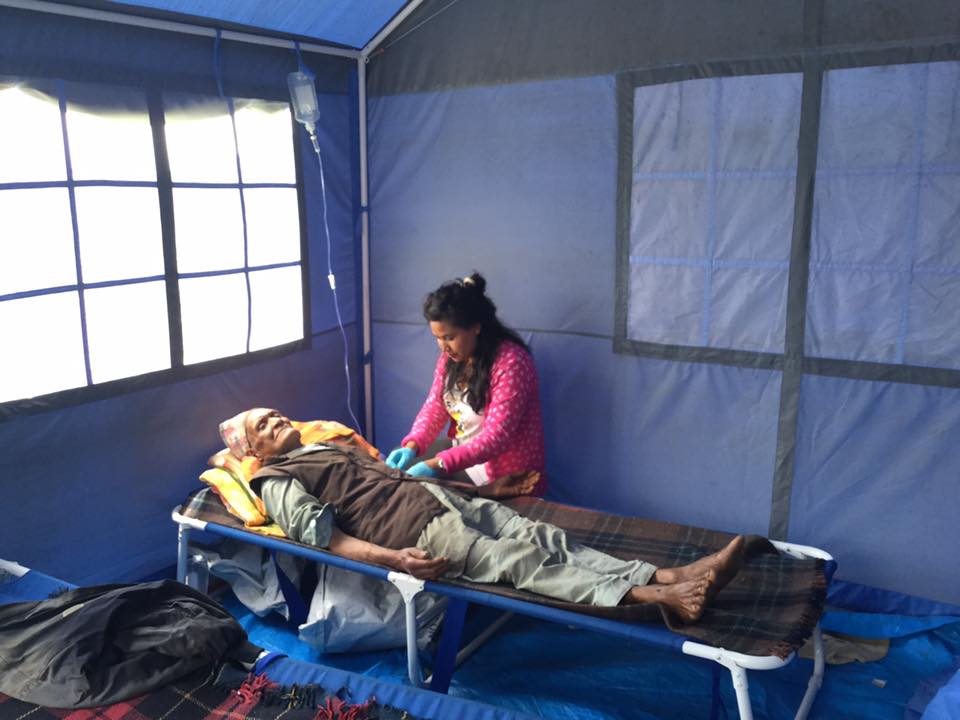
SMD alumna Pran Maya Khadki provides Health Assistance in Sindhupalchok District after the 2015 Nepal earthquakes
I was the only medical person there. While doing the treatments, I identified many cases. There were patients with acute tonsillitis, dysentery, diarrhea and injuries from falls. Likewise, there were other diseases such as typhoid, mumps, and chicken pox. Some of the common skin diseases were scabies, boils and abscesses. There were also patients suffering from dehydration and general weakness. I tried my very best to treat them. I referred complicated cases to hospitals in Kathmandu. Since it was monsoon season, there were many landslides so it was very difficult for patients to get to a better hospital.
Most patients visited me after walking for four to five hours, crossing deep jungles and steep trails. I was amazed and was so happy to treat them. Whenever I was called, I went to help them, even though they were far away from my duty station. Sometimes I had to wake up at midnight, but it did not bother me. This is my passion and the people deserved my help.
While I was in Sindhupalchok, I stayed with a Sherpa family. It was a large family with fifteen members including myself. They had a strong bond with each other. We used to have meals together which was fun. Mostly, we ate boiled potato and dido (dough made from corn flour) and sisno (nettle leaf), the staple food there.
Even though people were in difficult condition, they welcomed me with open hearts. They were so compassionate, loveable, social and funny. They respected me and never let me feel lonely. Over the course of my time there, I became so close to them that their memories shall remain in my mind all my life. I wish them a happy and healthy life.
There was no electricity or phone network so I had no regular phone calls with my parents and my friends at SMD. The place was surrounded by high hills. Often times, I felt earthquakes and landslides—that scared me a lot. Yet those hardships were nothing to me, as the village was so beautiful, mesmerizing and sacred.
I am extremely grateful to those who donated medicines and the local people for their support to run this program successfully.
Finally, I am very glad that I got this life-changing experience. I will be more than happy to engage in Health Assistants activities in the future. Also, I have a dream to continue my studies and help more people in need.
When Pran Maya came back to Kathmandu, she got a job at a health post in Chame, Manang District.
Ten other SMDers have become Health Assistants:
Our former SMD medic, monk Wangchuk Rapten, is looking after the free clinic, Thrangu Phende Clinic, at our Thrangu Tashi Yangtse Monastery, where the patient load is 14,000 people. In the earthquake time, he did 33 helicopter relief missions.
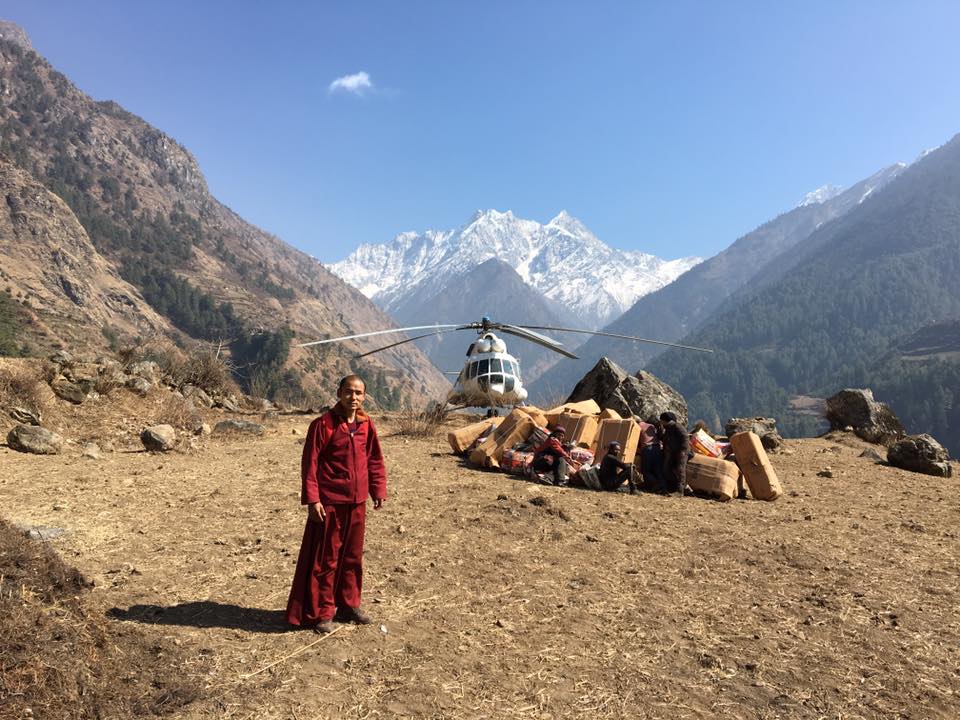
SMD alum Wangchuk Rapten provides health relief via helicopter missions after the 2015 Nepal earthquakes
After a year volunteering as a teacher in a village school, Nelha Sangmo returned to SMD School and finished her Health Assistants training. She took a post in Gorkha District (Bhi Village) funded by CANepal an INGO founded by the British climber, Doug Scott. Nelha worked for a year in Bhi (there had been no health care in Bhi until she went).
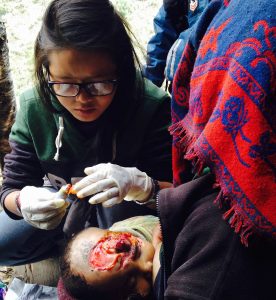
SMD Health Assistant Nelha Sangmo treats baby attacked by red monkey
The baby in the photo was attacked by a red monkey while his mum was working in the fields. The baby, a four-month-old boy was very badly injured. Nelha wrote, “There wasn’t anything on his head, just bone; the hole on the face expanded all the way to the tonsil. The location of the accident was a three-hour trek away from the place where I work. It took the family all day to get to me. The picture was taken after two weeks. I almost gave up on handling the patient, but I succeeded and am very happy with what I have done. Against all expectation, the baby survived.
Nelha is back at SMD School and on staff as one of our medical workers, working half-time. She has just begun an undergraduate degree in Public Health.
Tsewang Choden Lama also volunteered as a teacher in the mountains, then she came back to SMD, and did three years of paramedic training. After that she was offered a job at a health post in the mountains and worked there for a year (funding from CANepal). She saved her money and is now at university in Kathmandu, working on an undergraduate degree in Public Health.
After she finished three years of training, Phurbu Choden Lama worked for a year in the mountains (funding from CANepal). She also saved her money and is now at university in Kathmandu, working on an undergraduate degree in Public Health.
Phurbu wrote, “What motivates me to study medicine is that in my village the people are very ignorant about health and sanitation, and their traditional thinking and behavior and the great distances make them unwilling to visit health centers. Looking at the larger picture, the entire state of health care in Nepal itself is unsatisfactory because of poor governance and political instability. There are very few doctors—only two for every 10,000 people—because the majority of Nepalese doctors tend to leave the country.”
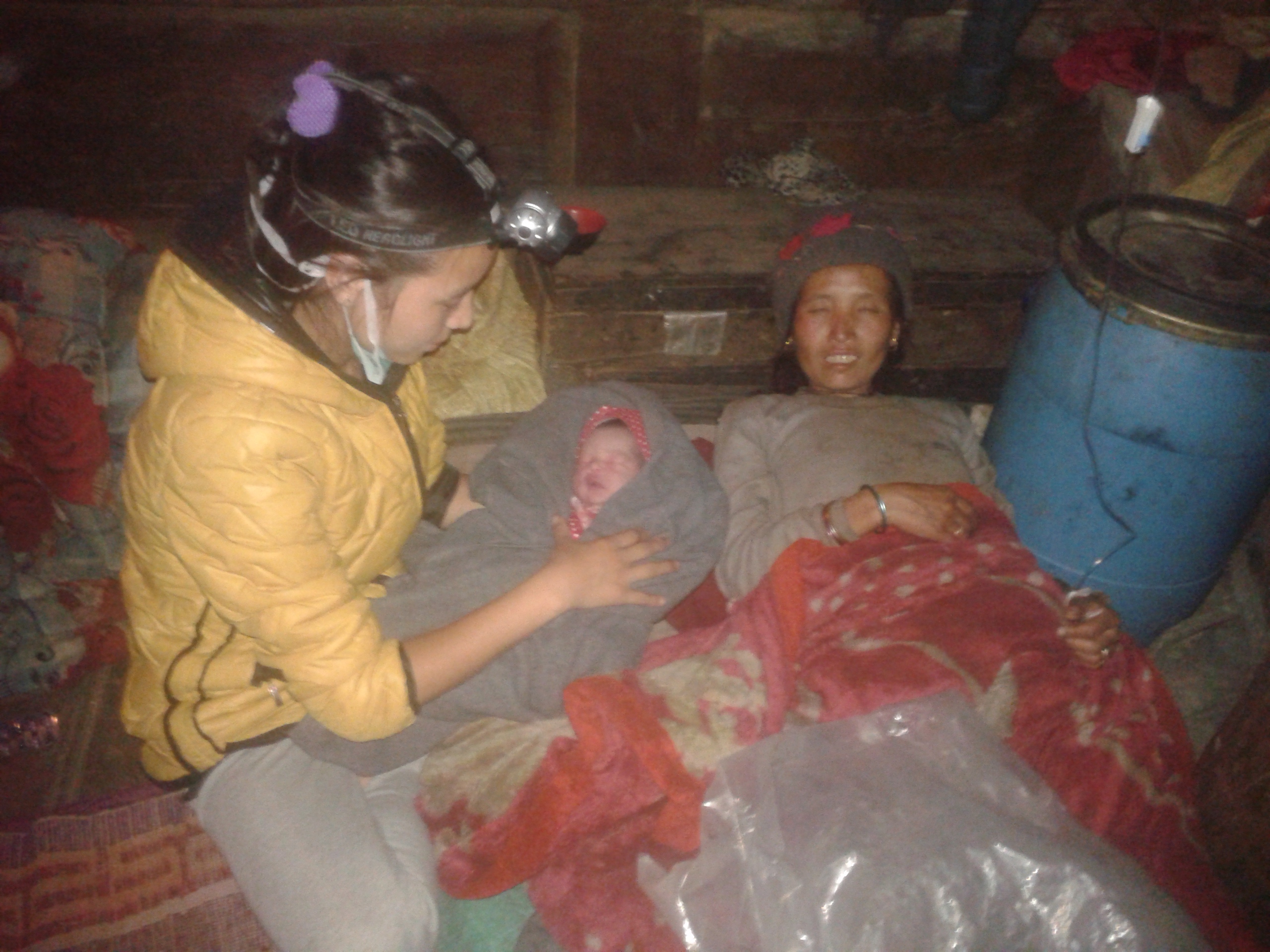
SMD alumna Phurbu Choden Lama provides Health Assistance in Himalayan Mountain village
After finishing Class 10, Pasang Lhamo Lama went to Shyala village to volunteer in a school founded by a lama. When she came back to SMD, she did the three-year Health Assistants training with the help of a sponsor. As soon as she was certified, she went back and is working in the mountains (Nubri, Lho village) with funding from CANepal.
Dorje Thinley Lama volunteered at SMD for a year, then, after three years of study and field work, certified as a Health Assistant, he returned to his village and worked for a year at Nar health post. Funding for salary, equipment and medicine came from the Wen Giving Foundation.

SMD alum Dorje Thinley Lama provides health assistance in Nar, Manang
Phurbu Sherpa gave service for a year at SMD before he started Health Assistants (paramedic) studies. There was no work for paramedics, but he worked a lot on relief missions during the earthquake time. He filled three trucks by himself with relief goods and took them into Sindhupalchok (the second epicentre) where he also did medical relief.
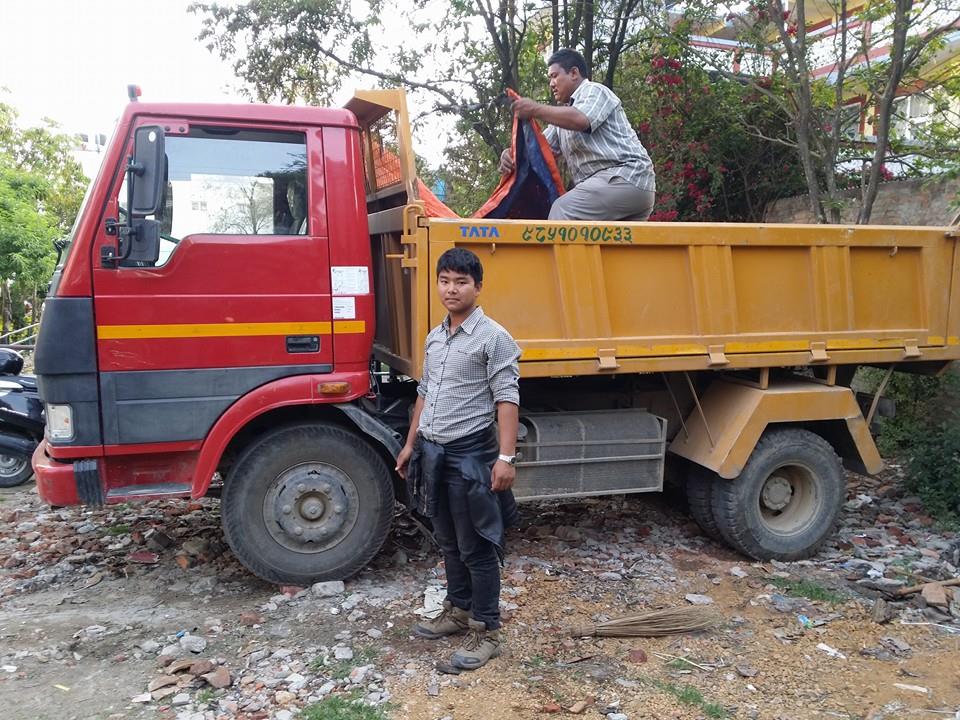
SMD Health Assistant Phurbu Sherpa provides relief work during the 2015 Nepal earthquakes
Dolma Sherpa gave service at SMD as a teacher, then she did the three-year paramedic training. Nowadays, she is working in Nepal, in remote areas (picking up short contracts). She’s had the chance to attend the Tzu Chi Buddhist Foundation medical conference in Taiwan, and more recently, she worked in the Compassion Health Centre in Tsum, Gorkha District. Funding for this work has come from Canada.
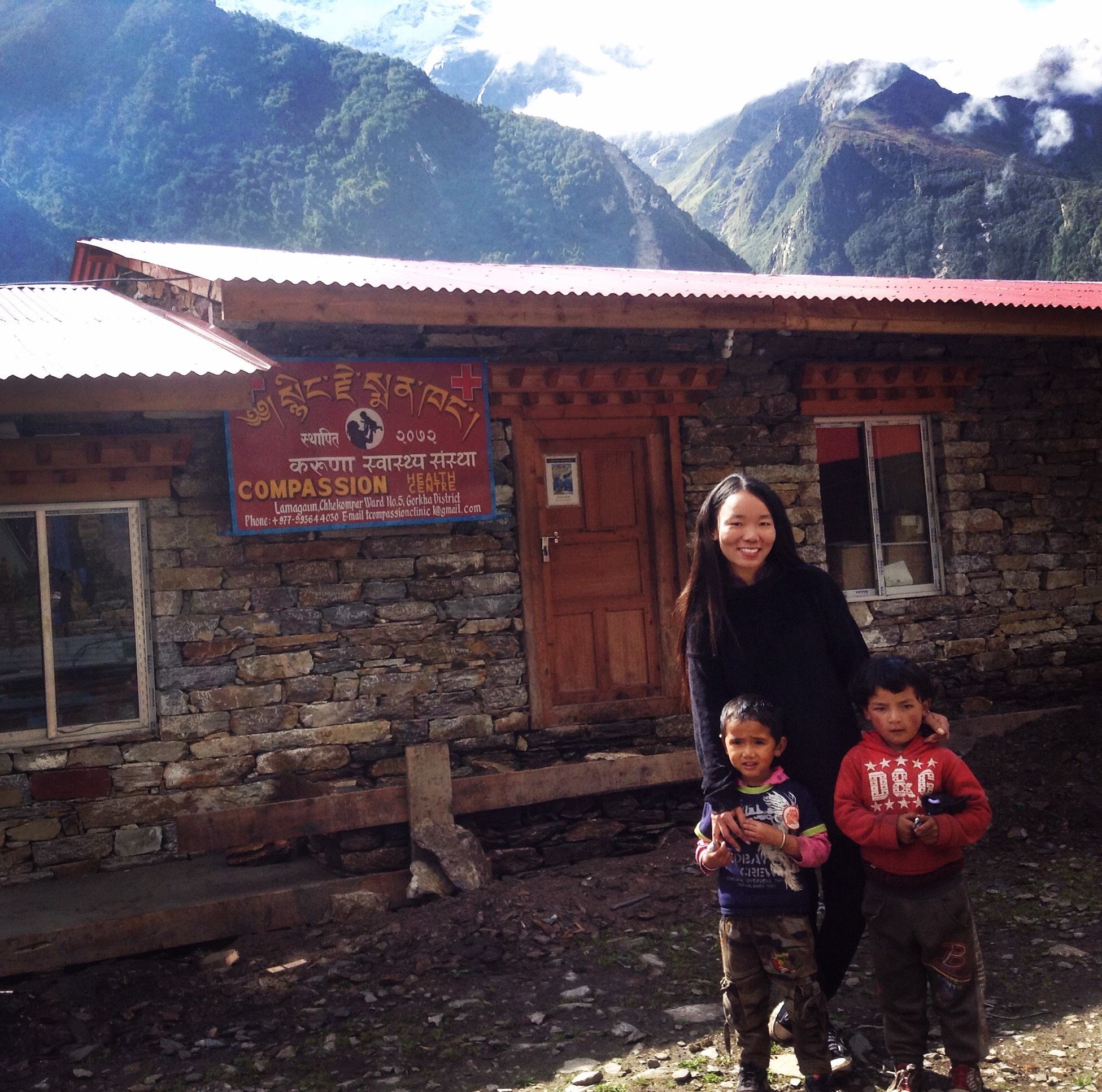
SMD alumna Dolma Sherpa provides health assistance at Compassion Health Post in Tsum, Gorkha District
Choden Yangchen Lama is currently running the health post in Nar, Manang District, taking over from Dorje Thinley Lama. Funding comes from the Wen Giving Foundation. When she first came to SMD as a young girl, I asked her if she had anything she wanted to say to the world: “Yes!” she declared. “All you adults out there, educate your children, especially your girls. When I grow up, I’m going to be a doctor, then I will go back to my village and I will look after the people in Nar.”
She comments, “The purpose of working in my own village is that I can understand their language and the problems that they have. They need someone speaking their own language to be able to share their problems so they can understand what is necessary for them to get better. I can prescribe in their own language so that medicines and treatment will help them and cure them smoothly.”

